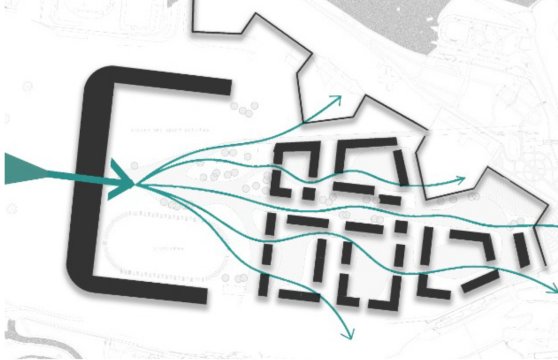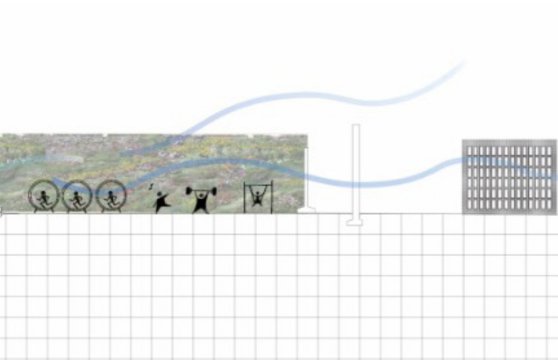A green jungle and a wind farm. Students have proposed a new use for Strahov Stadium
5/5/2022

There has been no clear consensus on the use of the Strahov area from the public or political representations for a long time. Nevertheless, in recent years, there has been a shift away from the tendency to develop the area with office or residential construction and, on the contrary, an effort to use the area as a place for recreation, leisure activities and cultural enjoyment for the inhabitants of Prague.
The students were given a free assignment by the city management and their teachers, they were not limited by established ideas or domestic perspectives and could fully discover the possibilities of the potential of the place. All projects offer a multi-purpose use of the site, focusing on sport, culture and education. They also address the issue of transport links and better connecting the stadium to the rest of the city. The proposals present student housing, a university headquarters, sports and cultural facilities to bold visions of an urban wind farm or a berth for airships delivering goods to the capital, which are then dispatched by drones.
The project THE ROOTS OF STRAHOV focused on an important feature of the stadium, its spatial isolation from its surroundings. The students decided to connect the site to the rest of the city, to make Strahov more accessible and to give the area potential for growth. They look at all modes of transport and the surrounding environment through which the roads pass.
Strahov as an inspiration for smart energy use is the WIND OF CHANGE project. The students took advantage of the climatic conditions, the strong wind they experienced at Strahov. As an energy source, they transformed the area on the site of the current Rošický Stadium into a landscape park with wind turbines. The redevelopment of the existing student halls of residence aims to create a zero-energy district.
The radical design of LET'S GROW STRAHOV leaves room for nature and encourages it to absorb the stadium and its surroundings. The team proposed that the site be left fallow for a period of time, its original character restored, and people invited back in only after the vegetation has returned. But only to carefully defined rest areas, natural playgrounds or wild camping.
The international workshop was attended by 18 students from the Klokočka and Rehwaldt studios of the FA CTU and 60 students from foreign schools of architecture of the Technical Universities of Delft, Krakow and Dresden and ENSA in Strasbourg. The work on the designs was preceded by introductory presentations and a site visit. Speakers included Petr Hlaváček, deputy mayor of Prague responsible for territorial development, Jaromír Hainc and Amáta Wenzelová from the Institute of Planning and Development, and Miroslav Pavel, architectural historian from the Department of Theory and History of Architecture at the FA CTU.
The final presentation took place at the Centre for Architecture and Urban Planning with the participation of representatives of the Prague City Hall, the Institute of Planning and Development, the Prague 6 Municipality and representatives of local associations. "It was extremely interesting to see how concepts are created unencumbered by local views and customs. All the students will continue working on the projects at their home universities. Their projects can inspire politicians and the professional public," says Jana Zdráhalová from the Department of Urban Design at the FA CTU.
RE_CYCLE_MATERIAL_STRAHOV
Marija Beloglazova – Sophie Niederkrüger – Emilia Groß – Zofia Frączek – Daniel Targosz – Nouhaila Belmajdoub – Vendula Hladoniková – Veronika Pokorná
The proposal is to use the Strahov stadium as a recycling centre. It is a place for craftsmen, tourists, workers or students. The proposal takes advantage of the possibility to separate the operation of the stands from the indoor practice area. It divides the existing structure of the stands into smaller spaces and inserts boxes that contain spaces for workshops. The workshops are available to the public in the form of leisure interest centres, people can learn new activities here, and they can also serve as rentable spaces. The grandstand space also offers temporary accommodation. This part is complemented by small restaurants, bistros, cafes. The open space between the dormitories is complemented by buildings made of recycled materials, creating a pleasant student boulevard. The new buildings will extend the range of services to include study rooms, community spaces or bike sheds.
STRAHOV YOURSELF
Amanda Daher – Anton Wunderlich – Betül Bilir – Kristyna Sterbova – Irmina Szostak – Lukáš Popelka – Natalia Kwolek – Natalia Ordonez
The design works with the idea of the stadium as a place of expression of national unity and identity. In response to the current lack of a unified vision that would unite the majority of society and give meaning to the large-scale construction of the stadium, the group comes up with the opposite concept. It envisages the stadium as a place for the expression of people's individuality, their interests, opinions, attitudes and activities. In this proposal, the stadium is transformed into a construction into which a free world of meanings, attitudes and activities is created by inserting diverse functions.
STRAHAHAHAHOV
Oumaima Belhamra – Yijun Chen – Jan Reinker – Aleksandra Stoszko – Michał Stryjski – Patricia Werner
The proposal transforms the stadium into a sports and entertainment centre, a place suitable for skating, pumptrack, climbing wall, water sports, etc. The proposal uses concrete structures to reinforce the street character of the sports represented. The centre is complemented by community and refreshment areas and commercial space.
WIND OF CHANGE
Oliwia Fila – Anne Rößger – Yvonne Kuo – Theodor Kalmer – Anna Białoń – Xristina Dreliosi – Petr Τajčman
The students took advantage of the climatic conditions, specifically the strong wind that they had the opportunity to experience at Strahov. Moreover, when they realized that the wind in Prague is mostly westerly, their concept was clear. Wind as a source of energy transformed the area where the current Rošický Stadium is located into a landscape park with wind turbines. One section of the stands was transformed into a wind turbine that uses the stadium structure for a funnel effect of airflow. Inside is a research centre for renewable energy. Another part of the stands appeals to students, offering them missing spaces for leisure activities, a library, sports facilities, commercially rentable spaces or community places. The student residence halls in this project also use solar energy and their building modifications or remodeling are aimed at creating a zero-energy neighborhood. The new look of Strahov provides inspiration for further development and smart energy use.
PORT(AL) STRAHOV: FROM PAST TO FUTURE
Aleksandra Knop – Emely Linke – Eveliina Kunnaton – Huyen Tran Tran – Lucie Fahim – Luisa Martins – Václav Týn
The proposal is based on the division of the stadium operation into stands and training ground. The training ground offers storage space for goods to be transported by air. In the proposal we can see the transport of goods by airships, the transfer and subsequent distribution around the city by drones. This type of transport will not burden the local roads with excessive traffic. In contrast to the use of the training ground, which will cover the whole of Prague, the stands "outwards" to the surrounding area have a local character. They offer amenities that are currently lacking locally. The clear division of the stadium into the private space of the training ground and the publicly accessible space on the outside of the stands will be temporarily changed only in exceptional cases. Such times occur, for example, when a music festival is held or when the practice area turns into a large ice rink in winter. Only then can people see the grounds from the inside.
THE PLAYGROUND
Margarita Gromyko – Niklas von Werder – Hayfra Mahmoud – Magdalena Marasik – Ewelina Kordek – Zuzana Nucová – Adam Hloušek
This group mapped how many students there are in Prague and in which locations the universities are located. (They saw a significant potential in students and created a place that would be for all students, regardless of their field of study, but for all action-oriented people with a desire to create. The authors decided to build just such a place at Stahov in Masaryk Stadium. The north and south stands are open so that it is possible to walk around. The area of the stands offers restaurants, shops, rentable spaces. This design emphasizes the spatial delineation of the bleacher sections for the student union, city, university and commercial entities. The division of space also corresponds to the division of the management of parts of the building and thus the operation of the stadium. The whole stadium is thus distinctly multifunctional, where parts of the operation can support the use of other parts. The training ground inside is polyfunctionally used as a sports and recreational "playground".
THE ROOTS OF STRAHOV
Larissa Haschel – Ruiqi Wang – Lukasz Bys – Aleksandra Kuzbida – Shixuan Li – Martin Trávníček
The design focused on one important characteristic of the stadium and that is the spatial isolation from the surroundings. The entire Strahov plain is on the spur of Petřín Hill and its street network is relatively segregated from the urban fabric. The project focuses on connecting the site to the rest of the city so that Strahov is more easily accessible and the site has potential for growth; it divides transport into public, pedestrian and cycling and considers the predominant direction from which tourists come. The paths are well discussed and attention is paid to the surrounding environment through which the paths pass.
CALM MIND, WILD HEART – STRAHOV
Zainab Boualam – Lydia Jahonnemann – Yiqi Xu – Virginia Lazarou – Weronika Zielinska – Blazej Kmonk – Karolina Vasinova
This proposal makes the area around the stadium a city in greenery – to the east are student dormitories, supplemented by new blocks; to the west is residential development. The whole area has significantly reduced car traffic and is dominated by pedestrian and cycling traffic; there are many areas for recreation, sport and relaxation in the green space. The stadium is being transformed into a centre of activity, both around the perimeter of the stands and inside. As a counterbalance to the free development in the surroundings, an intensive, multilayered "urban" centre is growing on the area of the training ground.
STRAHOV MAGNET
Anna Zipp – Sarah Meyer – Szymon Kolcz – Patrycja Kowalska – Miriam Langerová – Kristina Králová – Zuzanna Murzyn
Instead of Strahov Stadium as a magnet for people, as a source of energy and use. The proposal divides the stadium into four operationally separate wings. It does not turn their energy inwards, as it did for the sports games, but instead turns the use and power outwards. This creates spaces for a wide range of people, from artists, families with children, senior citizens, residents, students or tourists. By inserting additional structures, the stadium offers a range of spaces that will allow for a wealth of uses and transfers its energy to the practice field area. Here, within the leisure park, there are also specifically defined areas of playgrounds, vineyards or exhibition areas.
LET’S GROW STRAHOV
Angelika Palasz – Hind Boulaui – Josefin Froeschke – Mai Nguyen – Stas Borys –Tina Málková – Carmen Jansen op de Haar
A group of students leaves space for nature and encourages it to absorb the stadium and its surroundings. For an extended period of time, the site is left untouched. The original character of the site is restored at the site of the Great Stadium. Only after the return of vegetation are people invited back, this time to carefully defined resting places, natural playgrounds or wild camping.



































